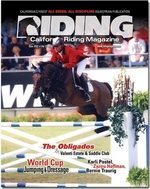Summer is here, and so is the heart of horse show season. The CDS Dressage Championships, the Menlo Charity Horse Show and the Oaks are just some of the competitions that can make even the most seasoned exhibitors feel some nervous anticipation.Sport Psychology In The Ring
Show nerves can be put to good use. by Tonya Johnston, MA
Appeared in
June ’07 issue of Riding Magazine
Summer is here, and so is the heart of horse show season. The CDS Dressage Championships, the Menlo Charity Horse Show and the Oaks are just some of the competitions that can make even the most seasoned exhibitors feel some nervous anticipation.
For other riders, a one-day schooling show or their first time at a multi-day horse show can bring out the butterflies. If you are showing at a venue that is important to you this summer, then you might already be feeling the excitement and some old-fashioned horse show nerves.
Graduate students in the sport psychology courses I teach sometimes ask, “Are nerves always bad?” My answer is “not necessarily.” No matter where you show, the riders who consistently do well are often those who simply know what to do with their nervous energy. In fact, many elite athletes worry when they don’t get a little “zap” before they compete. So, how can you develop the skills to harness your pre-show jitters? Three words: Practice, preparation and perception.
Practice
Can you practice riding with show nerves? Yes! By creating horse show situations and exercises that mirror the demands of your classes, you can begin to normalize the feelings you experience at the show. Before you ride an exercise or course, vividly imagine the show grounds, announcer, warm-up ring, back gate, and how you feel in your show clothes. In addition, warming-up in one ring and then riding a course or specific exercise in another ring is ideal. Another example for hunter/jumper riders is to begin a course by entering the ring as if you were at a show, picking up the canter in a formal opening circle, jumping your course, and finishing with a closing circle.
Imagining your rides at the show is mental practice. Often riders will experience butterflies by simply visualizing walking into the show ring. This is actually quite helpful as it provides an opportunity to work through the nervous distractions over and over again, thereby getting the mind and body used to the situation. Add feelings of confidence, control and focus to your imagery and you are on your way to successfully handling your show nerves.
Preparation
Prepare to demonstrate your riding skill at a horse show by setting performance goals. This type of goal helps you focus on the things within your control that create good rides. Examples of performance goals include looking early to the next jump or using leg and seat for all downward transitions. Integrating your performance goals into your test or course ensures you are focused on things you want to accomplish once you are in the ring.
Another important part of preparation has to do with treating yourself as a finely tuned athlete. Use excitement about an upcoming show to motivate you to work on the details of your personal training. Cardio fitness, strength training, nutrition, hydration and rest play an extremely important, yet often overlooked, part in riding confidently at a competition. Take control over these aspects of preparation and figure out a plan for integrating them into your routine. For example, clients will often tell me they can’t eat at shows because they feel nervous. I tell them, “Well, you can’t drive a car without any gas. So, let’s figure it out!” Nerves and tension thrive in an empty tank. Physical weakness, lightheadedness and shallow breathing are all signs that a negative spiral is in progress. Experiment with foods that work – complex carbohydrates, fruit and protein – and then be sure to have them on hand at the show.
Perception
“Butterflies in my stomach make me ride terribly.” “When I feel butterflies, it means I’m ready.” Which of those two statements do you identify with? Nervous energy can be channeled into productive thoughts and focus, or it can be destructive and distracting; you have a choice. Practice and preparation, as seen above, are elements in your control that allow you to perceive your heightened arousal as a good thing.
Use of a skill called “centering” can also aid you in redirecting your butterflies and help you feel strong and confident. Take a deep breath in through your nose and out through your mouth to ensure your center of gravity is at a point below and behind your belly button. As you exhale, for longer than you inhaled, let go of unwanted tension in your muscles. Imagine any extra energy you feel improving your position and balance, sending power to your legs, and lengthening your entire body from head to toe.
Good luck, harness those nervous butterflies and ride your best!
Tonya Johnston, MA, is a sport psychology consultant and hunter/jumper competitor. She has worked with equestrian athletes for the past 15 years and teaches in the Sport Psychology master’s program at JFK University. Tonya’s clients have attained competitive success at every level, including national titles and awards. Her website can be found at: www.TonyaJohnston.com.


